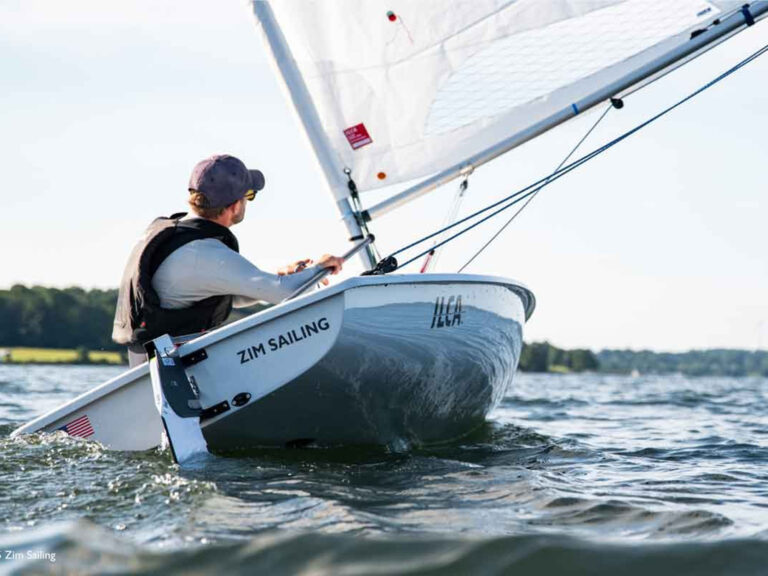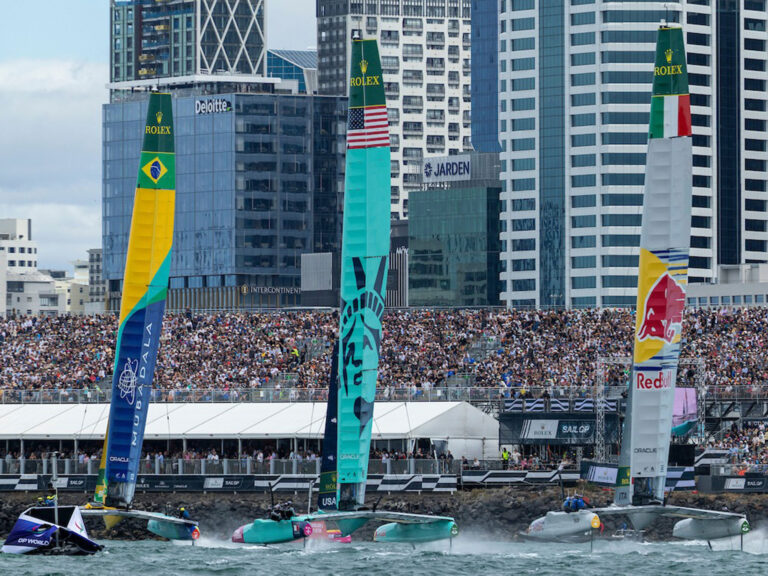_At the time, one of the more outspoken defenders of certain kinetic movements was Steve Taylor, the then reigning 505 World Champion, who had also held titles in a number of classes, including 420s, 470s and Flying Dutchmen. He shared his ideas about why some kinetics should be allowed and some should not. From Yacht Racing/Cruising‘s August 1980 issue._Paul Henderson’s desire to clarify the present situation is salutary, and I share it. But if either of his two somewhat extremist choices are adopted by the IYRU in November, smallboat racing will have been done a vast disservice and will be far less fun than it is even now in the midst of what, I agree, is a problem.He says, “We’ve got to either let it all go, or we can’t allow any of it.” This is simply not true, and his notions get into further trouble by his sweeping attempt to combine all body movement/trimming techniques into one amorphous “it” which he wishes to do away with.The most painfully obvious and easily dealt with examples of two very different phenomena, which he tries to tie together, are sculling and roll tacking. The former is, without doubt, the worst offender in the propulsion problem (except for boats with unsuitable rudders). The solutions: a) Every class with kick-up rudders could require that, from the preparatory signal until the finish, the rudder be within two degrees of vertical. b) Every class with fixed, barn-door type rudders good for sculling (e.g. FD, Finn, Interclub, etc.) that has a sculling problem simply re-write the rules, a rudder that is near-vertical, narrow, rectangular and fixed down. The expense of new rudders would be easily justified by the huge value of the result, not only in the elimination of sculling, but in the improvement of the boat in other conditions. c) In the meantime, a few rubber boats behind the starting line summarily ejecting offenders would deliver the well deserved frontier justice nearly all of us clamor for on this issue. Legitimate opinion on all the other issues is divided. Roll tacking is one of the nicest parts of the art of sailing, one of the real improvements in the quality of the sport in recent years. That it can be abused is true, but only mildly so. I’ve sailed rather intensely for the last eight years in four major dinghy classes and only once have seen a clear instance of roll tacking abused. In SPORT 1974, in a race subsequently cancelled for lack of wind, a Finn sailor increased his lead over his competitors by roll tacking through and beyond a 60-boat 470 fleet which had started 15 minutes ahead of him. The race was already a drifting travesty, and the only reason no one threw him out was because his action was entertaining a bored group of drifting competitors in a race that was obviously going to run over the time limit.That a 420 can gain the lead (in the race Henderson describes from CORK) by two quick tacks near the weather mark indicates astute and graceful sailing in response to a small shift. I can speak from experience about 420s (eds.¿Steve is a two-time 420 world champion), and can assure anyone that, on that day (I was sailing nearby in an FD), roll tacking alone, in the absence of a shift, would not have worked out as it apparently did. The fact that roll tacking makes you lose less than a normal (awful) tack, and therefore allows you to work with smaller shifts, makes racing more tactically fun than it’s ever been. The fact that people who perfect graceful technique do better than those who don’t is hardly astounding or evil. In what other sport do people who don’t practice succeed?In case it isn’t already obvious, think of car racing: sculling is like cheating on your horsepower allotment or turbo boost level or fuel supply limit. Roll tacking is to tacking like accelerating out of the turn after gracefully entering it is to hitting the brakes in the middle of it.Now to the real problems: pumping, ooching, and rocking. These are the legitimate gray areas where limited actions in reasonable circumstances improve the sport and our enjoyment of it, and which also are so easily and often abused that to simply say “anything goes” would be ruinous. The oft-proposed Black Flag rule offers little more than a poor Catch-22 as a solution. Imagine a 140-pound sailor going upwind in a Laser in 12 knots. If the flag were down (do nothing), he could not sail legally. He would either capsize or drift backwards in irons, unless either his tiller or mainsheet were grossly violating the restrictive provisions of that rule when the flag is down. With the Black Flag up in 12 knots, Laser racing would certainly be a ridiculous Marines calisthenics show. I’d like to offer a few ideas which would go a long way towards defining the problems in manageable terms: 1. Pumping downwind’spinnaker and main: the existing rule really isn’t that bad. Self-policing is ultimately the essential answer, though a system of jury proferred “warnings to place the onus” might help at major events. In some classes, a “pump through certain minimum purchase” rule might help. In the event of disputes or a jury watching, the best criteria is, who’s doing what relative to the boats around him? A boat flailing twice as often as the fleet average is far more likely to be guilty of infringement than is the first guy a jury man unfamiliar with the given class looks at. Pumping protests should require witnesses, partly to assure that people are not randomly or singly scapegoated and, equally important!y, to remove the stigma of “bad guy” from the protestor. If two top guys tell a third that he’s out of line, the third is less likely to take it as a personal vendetta and more likely to reform his ways. One thing for sure¿it will be a different amount of pumping permissible in different types of boats, and the rules must accept this, just as tacking too close ~s one thmg for Solings and another for Optimists.2. Pumping upwind¿main: as Paul Henderson suggests, doing this as a permissive action under Rule 60 is never legal. Therefore, one can say that in all underpowered conditions (which vary from boat to boat), pumping upwind is categorically illegal and, like sculling, can be banned.In overpowered conditions, accepted definitions of how pumping works make it unlikely that rapid trimming is ever to be seen as illegal upwind. One can use as a reasonable definition of overpowered the notion that if the sails are trimmed to a fixed, normal angle of attack, the boat will heel too much or tip over. This pretty much eliminates the possibility that the sails can be overtrimmed to an even greater-than-normal angle of attack to drive an “extra air wedge.” In short, the whole point of sailing effectively in overpowering conditions is to depower effectively, not to add power. If rapid trimming or abrupt helm movement or hard hiking over waves helps this process to be more efficient, it can be seen as good sailing, not as illegal kinetics or “abnormal” propulsion. They are simply a faster return to sailing from dumping abundant power provided by the natural action of wind on the sails. Basically, the problem of pumping upwind becomes a lot more black and white and, therefore, easier to deal with, when you consider the relative wind strength, type of boat, and crew weight involved.3. Rocking: to the extent that tipping the boat is done to steer it without rudder drag and is coupled with a sustained alteration of course, it’s an appropriate, desirable, and aesthetically pleasing technique. All other rocking beyond normal action of wind and water on the boat is simply illegal all the time. I see no reason to have to prevent the rocking which happens naturally (ocean racers would need gyros suitable for the Queen Mary), but certainly, it’s illegal and unnatural to promote it further. The easiest test for this is the relative one, using masts on the horizon. One boat violently swinging, compared to others, while not executing a-sustained change of course, is pretty clearly guilty. Again, it must be remembered that the fleet norm will vary from class to class.The time when rocking is perceived by most of us to be offensive is in light air, flat water, upwind or down. Then, it’s so obvious and gross that I’m pretty sure a rule that both requires and encourages witnesses for protests can make self-policing work. 4. Ooching: if one carefully applies all that I’ve said about pumping, the problem of ooching takes similar shape and is pretty well covered by the existing rule. Though not as inherently graceful and aesthetic as roll tacking, it has its fine moments and occasional place in our sport. Bothersome abuses of ooching are rare, and also, it’s selfcontrolled because, of all the kinetics, ooching is the quickest way to become slow whenever it’s inappropriate.ln summary, I’ll be the first to acknowledge that I don’t have all the answers, and that a problem does exist. Some of it lies in that different people genuinely want different things, and this must be accepted as much as possible. It is partly for this reason and largely because of the very different nature of the various kinetics involved that we MUST NOT accept Paul Henderson’s notion of “allow it all” or “ban it all.” Better that we live in the turbulence of the present rule than wreck dinghy sailing with either simplistic extreme. I think understanding how all the various movements truly differ, both in their effect on the rig and in the way in which they affect the aesthetics of our sport is the first step to providing reasonable rules to deal with the problem. They cannot be lumped together, and that’s Henderson’s main failing. But, obviously, he’s gotten us to think about it.





